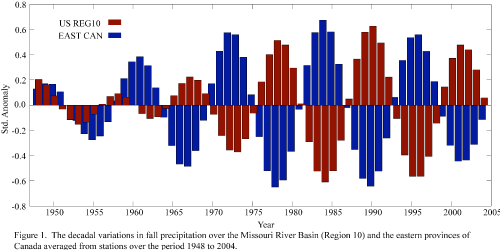A Precipitation Dipole in Eastern North America: Issues of Space-Time Variability and Physical Mechanisms
What do we know about a precipitation dipole in the US and Eastern Canada?
Recent studies suggest that the precipitation over Eastern North America (ENA) exhibits a dipole pattern of wet and dry conditions between the central United States and eastern Canada. This is evident in local trends: increases in precipitation and low to median stream flow are reported over the central and eastern United States, while decreases in precipitation and stream flow are reported in eastern Canada. Because of the opposing local changes, these large local trends are largely erased in the usual continental averages. This dipole pattern of precipitation appears to be spatially coherent over a range of temporal scales, contributing not only to trends but also to notable decadal fluctuations.

What do we not know about the ENA precipitation dipole?
The observed increases in precipitation are not well reproduced in current models and are contrary to the usual expectations of drying in the continental interior with a warmer climate. Several key aspects of this apparently coherent mode of precipitation variability, which is contributing strongly to trends, are not yet understood: What are the basic dynamics and physical mechanisms underlying this dipole pattern? How closely is it linked to large-scale climate variability? What process or processes are setting the decadal timescale?
Why do we need to know about the ENA precipitation dipole?
Understanding North American precipitation pattern and trends is a critical issue, both scientifically and with respect to decision-making, especially given the discrepancy between the observed trend and general global warming expectations. Knowledge of regional changes in precipitation and their long-term variations has important implications on how, and to what extent, long-term variations in precipitation in ENA can be predicted and managed. Several scientific questions are involved, including the dynamics of large-scale atmospheric influences on hydrology, mechanisms of hydrologic variability at decadal and longer timescales, and trend attribution. There is considerable societal impact as well, in terms of managing water resources, agriculture (e.g., winter wheat), water trade with Canada, and impacts of increased terrestrial carbon fluxes to stream perhaps due to increased autumn precipitation and associated increased connectivity of subsurface flow to streams.
What are our Goals, Objectives, and hypotheses?
The goals of this project are to determine the underlying dynamics of the dipole pattern and its connections to large-scale climate variability and trends. The three primary objectives of the proposed work are to: 1) determine the timescales, seasonality, and structure of the dipole pattern, 2) examine the dynamics of the precipitation changes in terms of the hydrologic budget, moisture transport, and storm track variability, and 3) use a hierarchy of models to investigate the influence of large-scale variability on the dipole mode. Key questions include: (a) What are the timescales, seasonality, and moisture sources of precipitation dipole over ENA? (b) Can we identify and characterize the atmospheric circulations that produce the ENA dipole? (c) Can we identify remote forcing(s) on the atmospheric patterns that produce this dipole? Based on our previous work and preliminary analyses, we propose two hypotheses for the regional dynamics (RD) of the precipitation dipole and two hypotheses for the dynamics of the large scale (LS) influence. We hypothesize that regional changes in precipitation are associated with RD1) modulation of moisture flux via circulation changes, and RD2) thermodynamically-forced changes in the vertical velocity. The regional dynamics are in turn influenced by the large-scale circulation via LS1) an equivalent-barotropic Rossby wave train excited by tropical convection in the western Pacific, and LS2) a local baroclinic response induced by convection in the Caribbean and possibly a secondary barotropic propagation over Canada produced possibly by increasing precipitation in the Central US.
What are our current findings?
Our current findings are summarized in the following selected publications, conference proceedings and presentations.
Small, D., S. Islam and M. Barlow (2010): The Impact of a Hemispheric Circulation
Regime on Fall Precipitation over North America, in press, Journal of Hydrometeorology.
Small, D., and S. Islam (2009): A synoptic view of trends and decadal variations in autumn precipitation across the United States from 1948 to 2004, J. Geophys. Res., 114, D10102, doi:10.1029/2008JD011579.
Jutla, A., Small, D., and S. Islam (2006): A precipitation dipole in eastern North America” Geophys. Res. Lett., 33, L21703, doi:10.1029/2006GL027500.
Tropical Linkages to Trends and Decadal Variations in Fall Hydroclimate over the United States 1948 – 2006, Small, D., Islam, S. and M. Ting. MOCA-09 General Assembly, July 19-29, 2009, Montreal, QC Canada.
Small, D L., Ting, M., and S. Islam (2009): The Impact of Large Scale Circulation Anomalies on the Moisture Flux over the United States in Observations and Models, Eos Trans. AGU, 90(52), Fall Meet. Suppl., Abstract GC33A-0713.
Who are working on this puzzle?
This collaborative project between the Tufts University and University of Massachusetts builds on mutually synergistic expertise in water cycle research, atmospheric dynamics, and hydrology.
Who is sponsoring this research?
This collaborative project is currently sponsored by the National Science Foundation (NSF 0809783 and NSF 0811099).